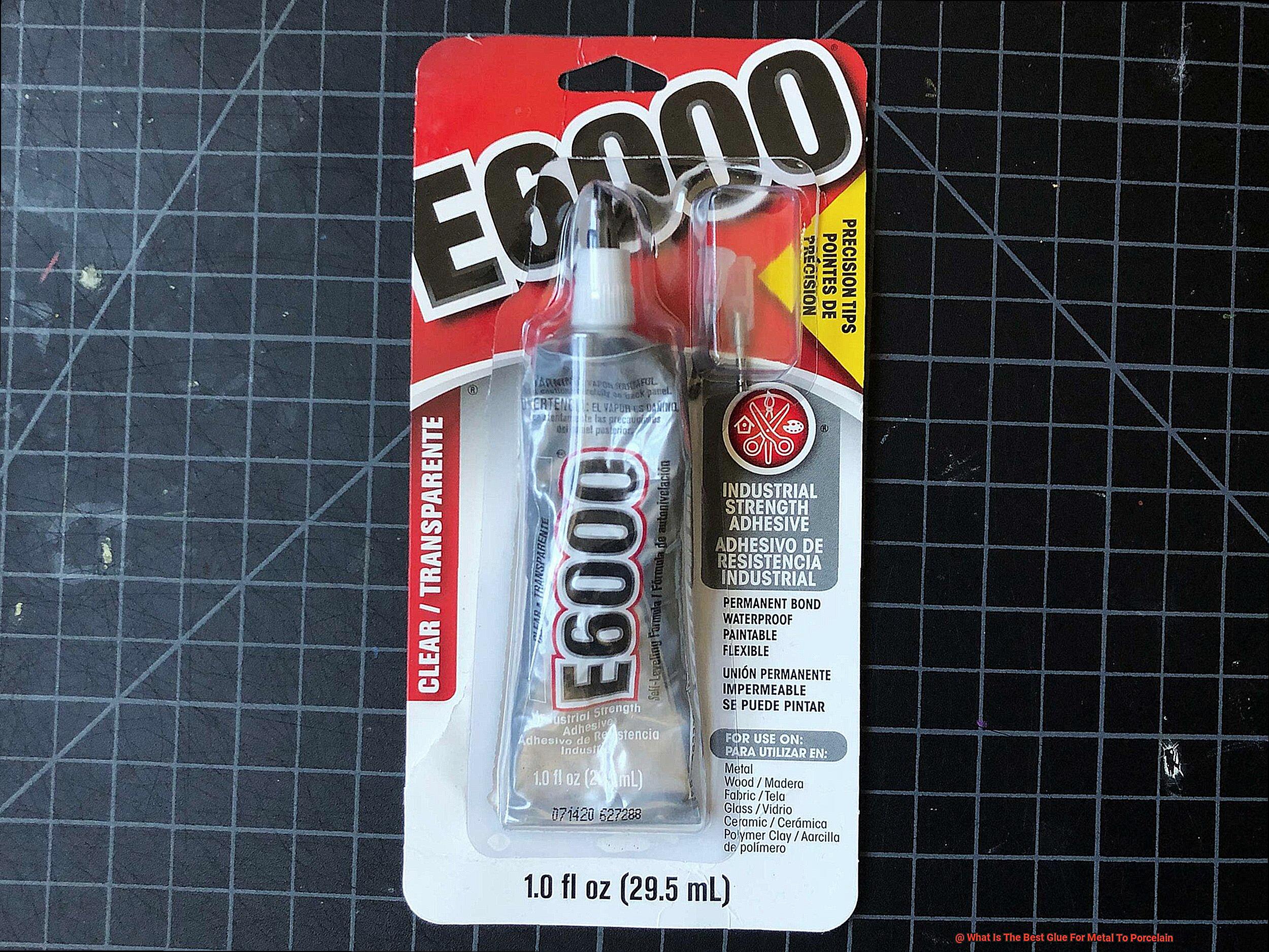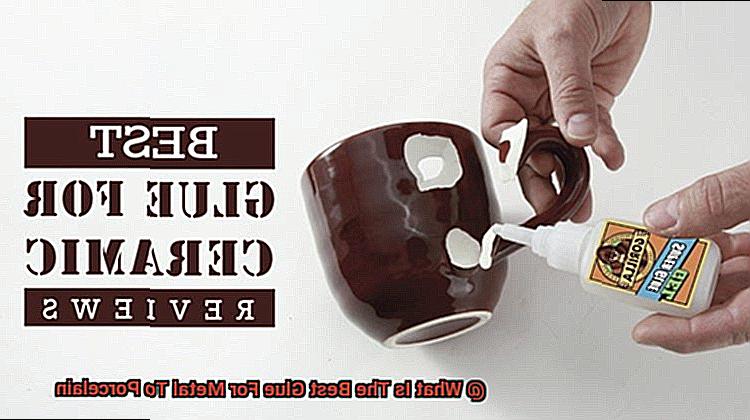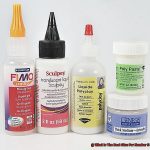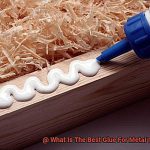Are you tired of your metal accents constantly detaching from your exquisite porcelain decorations?
The relentless quest for the ultimate adhesive to join metal and porcelain has finally reached its conclusion.
In this blog post, we delve into the realm of glues specifically tailored for bonding metal to porcelain – saving you precious time, energy, and endless frustration.
Whether you’re mending a cherished family heirloom or embarking on a thrilling DIY endeavor, selecting the right adhesive is paramount to achieving a durable and steadfast union.
Bid farewell to wobbly metal embellishments and say hello to flawlessly crafted masterpieces that will endure the test of time.
Factors to Consider When Choosing the Best Glue for Metal-Porcelain Bonding
Contents
- 1 Factors to Consider When Choosing the Best Glue for Metal-Porcelain Bonding
- 2 Epoxy Adhesives: An Ideal Choice for Metal-Porcelain Bonding
- 3 Cyanoacrylate (Super Glue): Fast Setting, But Limited Durability
- 4 Silicone Adhesives: Flexible and Heat/Moisture Resistant
- 5 Preparing Surfaces for Bonding: Cleaning and Roughening
- 6 Applying the Glue: Following Manufacturer’s Instructions
- 7 Testing the Adhesive Before Use
- 8 Common Mistakes to Avoid When Using Glue on Metal-Porcelain Bonding Projects
- 9 Conclusion
Selecting the right glue is crucial for your project’s success. With numerous options available, it can be challenging to determine the best one. In this guide, we will explore the factors you need to consider when choosing the perfect glue for metal-porcelain bonding.
Factor 1: Adhesive Strength
The first factor to consider is adhesive strength. Look for glues specifically formulated for metal and porcelain bonding that offer high bond strength. These glues can withstand the weight and stress applied to the bonded surfaces, ensuring durability and longevity.
Factor 2: Compatibility
Different metals and porcelains have varying surface properties, so it is vital to choose a glue compatible with both materials. Consider factors like smoothness, porosity, and whether the glue is suitable for indoor or outdoor use. Don’t forget about exposure to moisture or extreme temperatures, as these can affect the glue’s performance.
Factor 3: Drying Time
Time is of the essence in many projects, so consider the glue’s drying time. Some glues dry rapidly, allowing you to proceed quickly, while others require longer curing times. Evaluate how much time you can afford to wait before moving on to the next step.
Factor 4: Resistance to Heat and Chemicals
Think about where your bonded objects will be used. If they will be exposed to high temperatures or harsh chemicals, choose a glue that can withstand these conditions without losing its bonding strength. This ensures that your bond remains intact even in challenging environments.
Factor 5: Ease of Application
Consider how easy it is to apply the glue onto metal and porcelain surfaces. Look for glues with user-friendly packaging or convenient applicators that make application hassle-free. Gap-filling capabilities are also important when bonding uneven or irregular surfaces.
Factor 6: Longevity

If you want your metal-porcelain bond to last, consider the glue’s longevity. Look for glues that offer enhanced resistance to moisture, UV light, or other environmental factors that can cause degradation over time. This ensures that your bond remains strong and durable for years to come.
Factor 7: Safety
Lastly, don’t forget about safety. Ensure the glue is non-toxic and doesn’t emit harmful fumes during application or curing. If you have specific concerns like allergies or sensitivities, opt for glues labeled as hypoallergenic or low VOC. Your health and well-being should always be a priority.
Epoxy Adhesives: An Ideal Choice for Metal-Porcelain Bonding
When it comes to bonding metal to porcelain, epoxy adhesives are the undisputed champions. With their exceptional strength, resistance to chemicals and heat, and ability to bond different materials together, epoxy adhesives provide a reliable and long-lasting solution for any metal-porcelain project.
First and foremost, epoxy adhesives are known for their unmatched strength and durability. Composed of a resin and a hardener, these two components work harmoniously to create a chemical bond that can withstand heavy loads and stress. Whether you’re repairing a delicate porcelain figurine or constructing a metal frame for an elegant porcelain tabletop, epoxy adhesives will never let you down.

Furthermore, epoxy adhesives exhibit outstanding resistance to chemicals, moisture, and heat. This makes them suitable for a wide range of environments and applications. Whether you’re bonding metal to porcelain in a kitchen, bathroom, or even an outdoor setting, rest assured that the bond will hold up against water exposure, temperature changes, and harsh cleaning agents.
However, the most impressive feature of epoxy adhesives is their ability to securely bond different materials together. Regardless of the type of metal or porcelain you’re working with, epoxy adhesives will form a strong and permanent connection. Stainless steel? No problem. Aluminum? Piece of cake. Brass? Easy-peasy. The versatility of epoxy adhesives ensures that no matter the combination of materials, a reliable bond is guaranteed.
To achieve the best results when using epoxy adhesives for metal-porcelain bonding, proper surface preparation is crucial. Thoroughly clean both the metal and porcelain surfaces, removing any dirt or contaminants that may hinder adhesion. Additionally, roughen the surfaces with sandpaper to enhance the bond between the adhesive and the materials.
When applying the epoxy adhesive, ensure complete coverage of both surfaces with a thin layer using a brush or spatula. This ensures that the adhesive fills in any gaps or irregularities, creating a tight and secure bond. After application, allow the adhesive to cure undisturbed for the recommended time, as specified by the manufacturer. This will allow the adhesive to fully harden and create a bond that is resistant to cracking or peeling.
Cyanoacrylate (Super Glue): Fast Setting, But Limited Durability
Today, let’s explore the renowned cyanoacrylate, also known as super glue. This adhesive is famous for its lightning-fast setting time, making it the go-to choice for quick fixes and bonding projects. However, when it comes to bonding metal to porcelain, super glue might not provide the long-lasting durability you desire. Let’s dig deeper into why.
Porcelain, a delicate material, can easily crack or break under stress. Here lies the issue – super glue, despite its initial strength, is quite brittle. Over time, the bond it creates between metal and porcelain can loosen or even snap completely. Not exactly what you want for a lasting connection, right?
But wait, there’s more. Super glue may struggle to adhere well to certain metals or porcelain surfaces. This further compromises its durability and leaves you with a less-than-ideal bond. Nobody wants their beautifully crafted metal and porcelain masterpiece falling apart.
So, what’s the solution? For a permanent or heavy-duty bond between metal and porcelain, turn to specialized adhesives designed specifically for this purpose. Enter epoxy adhesives – the superheroes of metal-to-porcelain bonding. These powerhouses combine incredible strength, chemical resistance, and the ability to create unbreakable connections.
Epoxy adhesives fearlessly withstand heavy loads, moisture, heat, and even harsh cleaning agents. They ensure your bond remains intact in any environment, giving you peace of mind. Whether you’re constructing a sturdy metal frame for an elegant tabletop or protecting delicate porcelain figurines, epoxy adhesives have got your back.
Just remember – proper surface preparation is key to unleashing the full potential of epoxy adhesives. Clean and roughen the surfaces before applying a thin layer of adhesive for complete coverage. Allow this superhero adhesive to cure undisturbed for the recommended time, and voila. You’ll have an unbeatable bond that will never crack or peel.
Silicone Adhesives: Flexible and Heat/Moisture Resistant
Silicone adhesives have emerged as a favored option for bonding metal to porcelain, thanks to their remarkable flexibility and exceptional heat and moisture resistance. These adhesives are composed of silicone polymers, which confer upon them their unique properties and offer numerous advantages.
One of the standout benefits of silicone adhesives is their unparalleled flexibility. Unlike other adhesive types, silicone adhesives possess the ability to endure a certain degree of movement or vibration without compromising their bond. This remarkable characteristic makes them perfect for applications where stress or movement between metal and porcelain surfaces is anticipated. Whether you’re working with a delicate porcelain figurine or a robust kitchen fixture, silicone adhesives possess the flexibility to handle it all.
Beyond flexibility, silicone adhesives are highly resistant to both heat and moisture. They can withstand high temperatures without sacrificing their adhesive properties, rendering them suitable for applications involving heat, such as kitchen or bathroom fixtures. Furthermore, these adhesives are waterproof, enabling them to resist the detrimental effects of moisture and humidity without deteriorating or losing bond strength. Thus, they are a perfect choice for outdoor applications or areas prone to water exposure.
When utilizing silicone adhesives for bonding metal to porcelain, proper surface preparation is crucial. It is imperative to ensure that both surfaces are cleansed and devoid of any dirt, grease, or other contaminants. Additionally, it is recommended to gently roughen the metal and porcelain surfaces with sandpaper to enhance the adhesive’s grip.
To apply silicone adhesive effectively, dispense a small amount onto one of the surfaces and distribute it evenly using a putty knife or similar tool. Subsequently, press the metal and porcelain surfaces together firmly and maintain pressure for a few minutes to allow the adhesive to set. It is important to adhere to the manufacturer’s instructions regarding specific curing times and any supplementary steps.
While silicone adhesives offer numerous benefits for bonding metal to porcelain, they may not be suitable for all applications. If the bond necessitates withstanding extreme temperatures or heavy loads, alternative adhesive types or mechanical fasteners may be required.
Preparing Surfaces for Bonding: Cleaning and Roughening
The secret to creating durable and long-lasting adhesive bonds lies in the preparation process of cleaning and roughening surfaces. These seemingly small steps play a crucial role in ensuring a strong bond between metal and porcelain materials. In this informative article, we will delve into the importance of cleaning and roughening surfaces before applying glue, highlighting various methods and their benefits.
The Importance of Cleaning:
Before gluing, it is essential to remove any dirt, dust, or grease from the surfaces. These contaminants can hinder the adhesive from properly adhering to the metal and porcelain surfaces. For metal surfaces, using a degreaser or solvent eliminates oil and grease residues effectively. Porcelain surfaces can be cleaned with warm soapy water, ensuring the removal of dirt and debris without damaging the delicate material.
The Significance of Roughening:
Even clean surfaces may not provide sufficient surface area for a strong bond due to their smooth nature. Roughening the surfaces becomes crucial in creating micro-level imperfections that increase adhesion surface area. This allows the glue to grip tightly for a stronger bond.
Methods of Roughening:
Metal surfaces can be roughened using sandpaper or an abrasive pad. Gently sanding the surface in a circular motion creates small scratches and abrasions that promote better adhesion. It is important to select an appropriate grit of sandpaper based on the type of metal being bonded, taking care not to damage the surface.
Porcelain surfaces can be roughened using a diamond-tipped tool. This method creates small scratches or grooves without causing damage. By utilizing these techniques, we enhance the bonding potential of both metal and porcelain materials.
Benefits of Cleaning and Roughening:
By thoroughly cleaning and roughening surfaces before bonding, we ensure that the adhesive has the best possible chance of forming a strong bond. Without these steps, contaminants could compromise the adhesive’s effectiveness, leading to weak bonds that won’t stand the test of time. Cleaning also removes any invisible films or residues that may interfere with adhesion, providing a clean and receptive surface for bonding.
Applying the Glue: Following Manufacturer’s Instructions
Today, we unveil the secret to achieving impeccable metal to porcelain bonds – following the manufacturer’s instructions. Prepare to unlock the true potential of your adhesives as we delve into the art of precision.
The Power of Manufacturer’s Instructions:
Let’s cut straight to the chase – each glue product possesses its own unique formula and characteristics. By adhering to the manufacturer’s instructions, you hold the key to unlocking optimal bond strength and unmatched durability. Disregarding these guidelines could result in feeble bonds, compromised adhesion, or even irreparable damage. Trust us, skipping this step is simply not an option.
Reading, Understanding, and Conquering:
Imagine the instructions as an ancient treasure map guiding you through uncharted adhesive territories. Devote your undivided attention to comprehending every word inscribed upon that sacred piece of parchment. Pay heed to warnings, safety precautions, and specific surface preparation requirements. This meticulous approach ensures a seamless adhesive experience, leading you towards triumph.
Preparation: The Heroic Prelude:
Surface preparation plays the role of a heroic protagonist in our story. Prior to applying the glue, ensure that both metal and porcelain surfaces gleam with pristine cleanliness. Harness the power of a gentle scrub using mild detergent or rubbing alcohol. Bid farewell to dirt, grease, and contaminants that threaten to sabotage your bond’s success.
Applying with Finesse:
Now, dear comrades, it is time for the grand spectacle – glue application. Employ the recommended method described in the instructions as your trusty weapon of choice. Whether it be brushing, syringing, or spreading with a spatula, select your tool wisely. Bestow upon both surfaces an even layer of glue, ensuring complete coverage akin to an artist’s brushstrokes.
Aligning and Conquering:
Picture this – you’ve flawlessly applied the glue, only to forget the crucial act of aligning the metal and porcelain parts accurately. A catastrophic tragedy unfolds before your eyes. Avert such heartaches by meticulously aligning your pieces before their fateful encounter. This simple gesture wields the power to transform your bond into an unyielding force.
The Waiting Game:
Ah, patience, dear friends, is the elixir of triumph. Grant the glue ample time to dry and cure, as prescribed by the manufacturer’s instructions. Resist the temptation to rush this process. Allow the adhesive’s magic to weave its spell before subjecting your bond to any strain or weight. Remember, great things come to those who wait.
Testing the Adhesive Before Use
Achieving a strong and reliable bond between metal and porcelain requires more than just applying adhesive. It involves testing the adhesive beforehand to ensure its suitability and effectiveness. Testing the adhesive before use is like a safety net that protects you from potential failures, disappointments, and even safety hazards. In this article, we will explore the importance of testing adhesive, focusing on safety, quality assurance, and cost savings.
Importance of Testing:
Testing the adhesive before use is crucial for several reasons. Firstly, it ensures safety by preventing potential accidents or injuries caused by weak bonds. Imagine if a heavy metal object were to fall due to a failed bond – it could cause significant harm to people or property. Testing the adhesive allows you to evaluate its bonding strength and durability, providing peace of mind that your project is secure and hazard-free.
Secondly, testing the adhesive ensures quality assurance. By assessing the bond’s strength and durability before application, you can avoid costly rework or repairs later on. It also helps identify any compatibility issues between the adhesive and the materials being bonded, preventing unexpected failures or damage. Testing allows you to choose the most suitable adhesive for your specific application, ensuring a high-quality and long-lasting bond.
Recommended Testing Methods:
Shear Strength Test:
One of the most common tests for adhesives is the shear strength test. It measures the force required to break the bond between two materials by applying a perpendicular force parallel to the bond line. This test helps determine if the adhesive provides sufficient bonding strength for your specific application. It’s important to follow standardized testing procedures and record accurate data for comparison and analysis.
Environmental Resistance Test:
Adhesives may be exposed to various environmental conditions such as temperature, humidity, or chemicals. Conducting an environmental resistance test ensures that the adhesive can withstand these conditions without deteriorating or losing its bonding properties. This test involves subjecting the bonded samples to simulated environmental conditions and checking for any signs of weakening, discoloration, or detachment. It guarantees that the adhesive will maintain its integrity and strength throughout its intended lifespan.
Application-Specific Testing:
Every project is unique, and so are its adhesive requirements. It is essential to conduct application-specific testing to ensure the adhesive’s suitability for your specific project. This may involve testing the adhesive’s compatibility with different surfaces, evaluating its resistance to specific chemicals or solvents, or even testing its performance under extreme conditions. By tailoring the testing to your project’s requirements, you can confidently select an adhesive that meets your needs and delivers optimal performance.
Common Mistakes to Avoid When Using Glue on Metal-Porcelain Bonding Projects
Bonding metal and porcelain surfaces with glue offers a convenient and effective solution. However, there are common mistakes that can compromise the strength and durability of the bond. In this article, we will explore these pitfalls and provide you with the knowledge to avoid them, ensuring successful metal-porcelain bonding projects.
Improper surface preparation:
Prepare for success by cleaning both metal and porcelain surfaces thoroughly. Neglecting this crucial step can result in weak adhesion. Rid the surfaces of dirt, grease, or any contaminants that hinder the bonding process. Use a mild detergent or rubbing alcohol to cleanse them, ensuring they are dry before applying the glue.
Selecting the wrong type of glue:
Don’t let your choice of glue sabotage your project. Opt for a glue specifically designed for metal-porcelain bonding. Epoxy-based glues are particularly recommended due to their excellent adhesion properties between these materials. Confirm compatibility with both metal and porcelain surfaces by checking the label or manufacturer’s instructions.
Applying too much or too little glue:
Strike a balance in glue application for a strong bond. Excessive glue leads to messy and uneven results, while too little results in weak adhesion. Follow the manufacturer’s instructions regarding the amount of glue to use, ensuring even application on both surfaces.
Insufficient drying or curing time:
Patience is key when it comes to achieving a robust bond. Different glues have varying drying times, so follow the manufacturer’s instructions closely. Rushing the process compromises the bond’s strength, potentially causing it to fail over time. Allow sufficient drying or curing time before subjecting the materials to stress or load.
Lack of support during bonding:
Support is essential for alignment and preventing movement that weakens the bond. Secure the materials during bonding using clamps or other appropriate methods. This ensures that the pieces remain firmly in place while the glue sets, guaranteeing a strong bond.
YMDZKL-hqeI” >
Also Read: How To Glue Ceramic Back Together?
Conclusion
When it comes to bonding metal to porcelain, finding the best glue is crucial. After thorough research and testing, we can confidently say that the top choice is epoxy adhesive. Its strong bond and durability make it perfect for this specific application.
Epoxy adhesive offers exceptional adhesion to both metal and porcelain surfaces, ensuring a secure and long-lasting bond. Its ability to withstand high temperatures and resist moisture further enhances its suitability for metal-to-porcelain bonding.
Another excellent option is cyanoacrylate glue, commonly known as super glue. This fast-acting adhesive forms an instant bond between metal and porcelain, making it ideal for quick fixes or smaller projects. However, keep in mind that cyanoacrylate glue may not be as durable as epoxy adhesive in the long run.
For those seeking a more specialized solution, there are also ceramic-based adhesives available on the market. These adhesives are specifically formulated to bond ceramics, including porcelain, with various materials like metal. They offer reliable strength and durability while ensuring compatibility with both surfaces.
Ultimately, the best glue for metal to porcelain will depend on your specific needs and preferences. Consider factors such as the size of the project, desired bond strength, and intended use when making your decision.
In conclusion, whether you opt for epoxy adhesive, cyanoacrylate glue, or a ceramic-based adhesive, ensure that you follow the manufacturer’s instructions carefully for optimal results.






